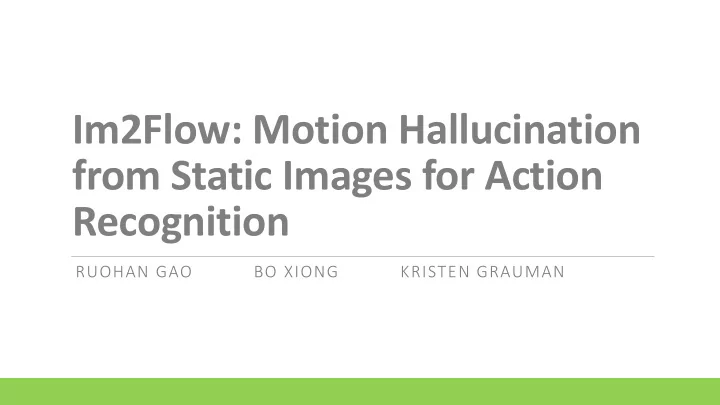

Im2Flow: Motion Hallucination from Static Images for Action Recognition RUOHAN GAO BO XIONG KRISTEN GRAUMAN
Action Recognition? Image Classification Object Detection/Localization What is an action? Semantic Segmentation Instance Segmentation
Problem: Action Recognition • Action is the most elementary human-surrounding interaction with a meaning. • Multi-classification Problem • Input: Video or Image • Output: Labels (categories of actions) • Human Action Recognition Input: Running, Kicking and Jumping Action 1; Action 2;... Action N Output:
Video-based Action Recognition • Classify human actions in video clips • Simplification: Trimmed Video with action lables • Datasets: UCF101; HMDB51; MSR Action 3D; • Temporal Action Detection/Localization: Untrimmed Video
Video-based Action Recognition • Rich Temporal Information + Motion Information ( Optical Flow ) • Motion field = real 3D scene motion • Optical flow = projection of motion field, the apparent motion of brightness patterns • 2D vector represents Instantaneous velocity CCD 3D motion vector 2D optical flow vector ( ) u = u , v Pierre Kornprobst's Demo
Time = t Time = t+dt Optical Flow Estimation • Brightness constant ( ) x , y • Motion is tiny ( ) + + x dx y dy , • Spatial consistency ( ) ( ) = + + + I x dx y dy t dt I x y t , , , ,
Optical Flow and Action Recognition • iDT ( improved dense trajectories) • DT: OF > trajectories (HOF, HOG, MBH, trajectory) > FV ( Fisher Vector ) > SVM • iDT: matching using optical flow and SURF • Two Stream Network (UCF101-88.0% , HMDB51-59.4%)
Why Optical Flow needed for Action Recognition? • On the Integration of Optical Flow and Action Recognition • Invariant to appearance, even when the flow vectors are inaccurate. Static Image Action Recognition • Representation based solution • high-level cues: human body or body parts, objects , human-object interactions, and scene context • Big Issue! • No Temporal information? No Motion information?
Solution: Motion Hallucination • Train a U-Net (adapted) on Youtube data to learn motion (static frame > 5 predicted OFs) • Losses: a pixel error loss and a motion content loss • two-stream CNN architecture
Flow Prediction • 3 datasets: UCF-101, HMDB-51, and Weizmann. • Evaluation metrics : (𝑣 0 − 𝑣 1 ) 2 +(𝑤 0 − 𝑤 1 ) 2 • End-Point-Error (EPE) • Direction Similarity (DS) • Orientation Similarity (OS) Quantitative results
Action Recognition • 3 static-image datasets (video datasets): • 4 Baselines UCF-101, HMDB-51, Penn Action • Appearance Stream • 3 static-image action benchmarks: • Motion Stream (Ground-truth) Willow, Stanford10, PASCAL2012 • Motion Stream (Walker) Actions • Appearance + Appearance • YUP++ Dynamic Scenes
inferred motion can help static image action recognition
Static-image action recognition results (in %) on the static-YUP++ dataset Comparison to other recognition models on Willow Conclusion • Approach: hallucinate the motion from static image and use it as an auxiliary cue for action recognition • state-of-the-art performance on optical flow prediction from an individual image • Standard two-stream network to enhance recognition of actions and dynamic scenes by a good margin
Recommend
More recommend